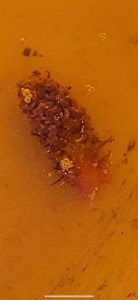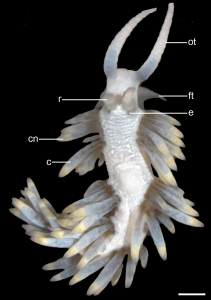

Every now and then, we get a true “what IS it?” come through our office. A couple of weeks ago, a local oysterman found one of the weirdest organisms I’ve ever seen. This tiny creature was only an inch long, and had what looked like fleshy bull horns protruding from its head. There were rows of additional little tentacles down its entire back, which it waved around frantically upon its discovery. The oyster farmer shared photos with Thomas, our Santa Rosa County Sea Grant agent, who then shared it with Rick and me in Escambia County.
Generally, the more bizarre spineless critters around here are some variety of sea slug (nudibranch) or sea squirt (tunicate). This was no exception. While I’ve covered “sea pork” and colleagues have written about other nudibranchs (Latin “naked” and Greek “gills”) on our Extension blogs, this little thing was stranger than usual. My first impression was, “a pinecone with horns,” or a “magnolia seed pod with barnacles.”

Thomas confirmed this particular sea slug was a Brazilian aeolid (Spurilla braziliana), which none of us three had seen in our collective ~125 years of marine field experience and curiosity. There are at least 3,000 species of nudibranchs, and this aeolid was first identified off the coast of Brazil. It has been found throughout the Gulf of Mexico, Caribbean, and along the Pacific coast, but sightings are rare everywhere in its territory. Surprisingly, this one was in an oyster sack in East Bay, near the south landing of the Garcon Point bridge.

Looking through photos taken by observers on iNaturalist, this species comes in nearly every color of the rainbow. From dull gray/beige to electric blue, yellow, bright coral/pink, and orange, they all exhibit the same tiny slug body with dozens of protrusions along their backs. The colors are associated with their food sources, although they appear to have chromatophores to blend in the way an octopus hides in plain sight by matching surrounding patterns. Hermaphroditic nudibranchs use their male and female reproductive organs to produce some wild looking egg masses, which are laid in a pattern looking (to me) like a string of ramen noodles.

The Brazilian aeolid has eyespots and can detect light and dark, but otherwise has very little vision. Their unusual anatomy is composed of specialized tentacles. The “horns” are oral tentacles and directly behind and on the side are “foot” tentacles. The remaining ones covering their backs are called cerata, which is Greek for horn. The cerata are external gills, which increase surface area for breathing like the bronchi in our lungs. Cerata are multifunctional and can be used for digestion and as weapons. Nudibranchs feed on sea anemones, jellyfish, and corals, and can take in their stinging cells for protection into structures called cnidosacs. A nudibranch can drop individual cerata the way a lizard drops its tail, leaving a sticky, wiggly distraction while it escapes a predator.
Sea slugs are benthic, meaning they crawl on the sea floor, and may be found in intracoastal waters (like the bay) or in deep oceans. They are considered indicator species, which means their presence (or absence) can inform biologists about the health of their surrounding waters.
 11
11
